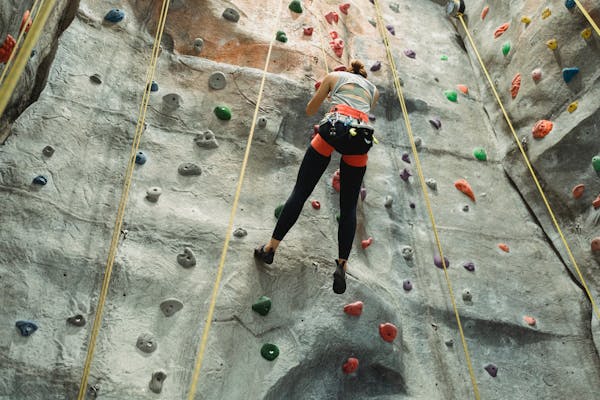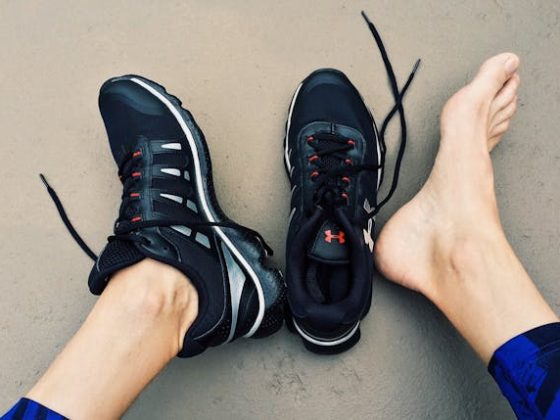Rock climbing has become quite popular, with many gyms and even tourists destinations offering rock climbing walls these days. Whether you are climbing for sport, exercise or just for fun there are both physical and mental benefits that can be derived from working your way up the wall. This article will tackle these rock climbing benefits, including their definition and types for your overall health and needs.
What is Rock Climbing?
Rock climbing entails the challenging activity of ascending rock faces, typically using ropes and specialized gear to reach a summit or endpoint. It demands physical strength, agility, and mental resilience to conquer ascents or traverses, often considered an adventurous pursuit despite its inherent risks.
Various types of rock, including igneous (such as granite), sedimentary (like limestone and sandstone), and metamorphic (including gneiss), offer diverse climbing opportunities worldwide. Additionally, artificial walls provide venues for climbing courses and routes.
Rock climbing encompasses different styles and environments, each requiring specific equipment and skills to navigate the terrain effectively.
Types of Rock Climbing:
Bouldering
Bouldering is a fundamental climbing style suitable for both indoor and outdoor environments. Climbers navigate short routes without harnesses or ropes, tackling small rocks or boulders. Although bouldering routes typically have shorter heights, they offer intricate and demanding challenges.
Minimal equipment is required, often limited to a protective cushion or pad positioned beneath the climb to cushion falls. Additionally, climbers use chalk and specialized climbing shoes for improved grip. Bouldering can be pursued solo or with the assistance of a spotter.
Sport Climbing
Sports climbing primarily occurs outdoors, although indoor facilities are also available for this style. In sport climbing, climbers ascend established rock faces with a partner, a belayer, who manages a rope. The routes in sport climbing are generally higher, necessitating a more comprehensive array of safety gear.
Key equipment includes a harness, ropes, and a belay system, alongside additional safety gear like helmets, chalk, climbing shoes, slings, and quickdraws.
There are two types of climbing routes: single-pitch and multi-pitch. In single-pitch climbing, the climber ascends and descends with the assistance of the belayer. Multi-pitch climbing consists of more than one of these levels.
Sport climbing encompasses top-rope climbing and lead climbing. Top-rope climbing entails setting up an anchor rope at the route’s top for the climbing rope to pass through. In lead climbing, the lead climber ascends and installs the quickdraws along the rock face.
Trad Climbing
Trad climbing resembles sport climbing, but the bolts are not pre-secured onto the route. Climbers must place bolts along the rock face during the ascent, and upon completion, all equipment must be removed from the wall. This style requires carrying nuts and camming devices during the climb, making it more challenging as climbers must locate the route and secure the equipment independently.
Dry Tooling
Dry tooling involves ascending the rock by placing ice axes into the wall and using crampons instead of climbing shoes. It incorporates ropes, harnesses, and gear typically used in sport climbing. However, the potential damage to the rock has sparked controversy surrounding this style of climbing.
Big Wall Climbing
Big wall climbing entails scaling long multi-pitch routes on vertical rock faces, often spanning multiple days. The allure of sleeping on the side of a rock wall adds to this type of climbing appeal.
Aid climbing involves placing removable equipment along the rock and attaching a webbing ladder. This process is repeated along the route and is commonly associated with big wall climbing.
Alpine Climbing
Alpine climbing focuses on ascending to summits or peaks, akin to mountaineering. It encompasses climbing over rock, ice, and snow, potentially traversing glaciers with a higher technical level.

What Is the Optimal Time for Rock Climbing?
A moderate climate is preferred for outdoor climbing, with spring, summer, and fall providing the most favorable weather conditions. Extreme weather can pose challenges and risks, making it harder to complete routes or climbs safely and successfully.
During the peak of summer, certain surfaces can absorb heat, posing challenges for climbers, while the cold during winter may impede a climber’s progress on surfaces. Nevertheless, indoor climbing gyms and diverse natural landscapes globally ensure that climbing opportunities are accessible year-round.
Rock Climbing Benefits:
Physical Benefits
-
Improving cardiovascular fitness:
Climbing is good cardiovascular training. According to a 2007 study published in the Journal of Undergraduate Kinesiology Research from the University of Wisconsin, rock climbing reaches the standards established by the American College of Sports Medicine for heart rate and energy output.
-
Boosting activity level:
A study done by Purdue University estimates that rock climbing equates to 244 steps per minute, which is comparable to running a 10 minute mile. Whether climbing indoors or outdoors, you can crank up the intensity level by how quickly you climb, the kind of surface you climb or the length of time spent climbing.
-
Calorie burning:
Depending on the effort you put into your climb and how many breaks you take, you can burn anywhere from 500 to 900 calories per hour while rock climbing.
-
Muscle building:
Climbing engages nearly all of the major muscle groups, strengthening the core, legs, arms, chest and back muscles. The often-forgotten muscles of the hand and forearm will strengthen as a result of climbing, as well.
-
Added benefits:
Your balance and coordination will also improve with regular climbs. As you navigate a climb, finding hand and footholds, pulling and propelling yourself, the body responds to the demands resulting in an overall enhancement in balance and coordination.
Mental Benefits
-
Mental Focus:
Throughout a typical day, human beings experience a plethora of mental stimuli. Climbing teaches you to reign in your thoughts and eliminate distractions, thereby, sharpening your mental focus.
-
Concentration:
Successful climbing requires the ability to narrow your concentration and fixate only on the hand and footholds. Planning and strategizing to determine the necessary route are the keys to making it to the finish.
-
Awareness:
Whether you do it indoors or outdoors, there is always the potential of slipping or falling. This leads to a heightened sense of awareness, something climbers can master through visualization.
-
Mental toughness:
No doubt you will experience numerous external and internal distractions during a climb, and dealing with these can lead to mental toughness. The act of climbing necessitates a steady mind that is willing to do whatever it takes to meet the challenge of the task.
-
Stress reduction:
Like other forms of physical exertion, you will experience the release of endorphins causing you to feel good. It will elevate your mood and thereby reduce harmful stress. If you are climbing in an outdoor setting, being in nature will increase your peace of mind and if nothing else, will take your mind of the day’s worries.
- Confidence: Successfully scaling a mountain is no small feat. How many people do you know that can say they have ever done it? Whether you’re climbing a wall or boulder, the sense of accomplishment associated with climbing can amplify one’s self confidence and self-reliance.
- Problem solving: No doubt when you are standing at the bottom of a massive rock, you are awestruck. As a climber you have to figure out how to make it to the top, which involves a significant amount of problem solving. You face a constant mental challenge while exerting yourself physically.
Social Benefits
-
Team building:
Rock climbing in small groups forces those in the group to strategize a course of action and to execute. Each is responsible for the others’ safety and without everyone’s cooperation they will fail. This type of teamwork builds confidence and trust. In fact, many climbing organizations offer corporate seminars that use the climbing experience to help workers learn to work together more effectively. This activity can have the same positive results for families too.
-
Connect with others:
Rock climbing is a great way to meet and get to know other people. There are many online networks that help bring climbers together. By using these sites you can find partners and keep up with fellow climbers. You might even join a climbing team and climb competitively. Amongst other climbers you will find a great deal of encouragement.

Getting Started:
The best way to begin your ascension into the sport of rock climbing is to just start climbing. A safe bet is to start at an indoor climbing facility. While indoor climbing may not seem as legitimate as outdoor climbing to some, it represents a safe segue into the sport.
Here you can learn the basics and get safety tips and pointers from a trained professional. Indoor climbing is challenging and can serve as a good training ground for those wanting to graduate to outdoor climbs. Regular climbs will bring about improved flexibility, muscular strength and endurance, as well as mental focus. Another perk is that indoor climbing is not limited by inclement weather.
What to Expect
Rocking climbing, like any vigorous physical activity, will leave you sore. It’s a total body workout, so expect to feel it from your fingers all the way down to your toes. Count on slipping a few times, getting stuck trying to find the right foothold and maybe even finding yourself back at the start pointing after only a few steps.
Conclusion:
Consider it all par for the course. You will improve you overall fitness, turbo boost your brain power and break out of your training rut. Rock climbing is a great way to train yourself to push through mental and physical challenges not only on a rock but also in life.




